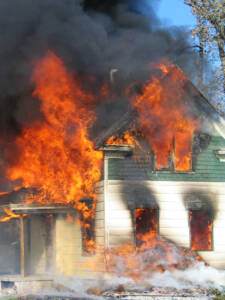How Homes Ignite
WILDFIRES SPREAD BY A COMBINATION OF A MOVING, FLAMING FIRE “FRONT,” AND AIRBORNE EMBERS CARRIED BY SMOKE AND WIND.

Buildings ignite during wildfires as a result of one or more of the three basic wildfire exposures, which include:
- Embers (also called Firebrands) – Embers are small pieces of burning material that can travel more than a mile ahead of a wildfire. They can create spot fires when they land on combustible materials, such as leaves in your gutter or plants under your windows.
- Radiant heat – The radiant heat generated from burning structures or plants can be hot enough to ignite a house without direct flame contact. This is particularly challenging in densely populated areas, where the heat from one burning home can ignite the next.
- Direct flame – Depending on time and exposure, direct flame contact can ignite your home. The flaming front of a wildfire is often not hot enough to ignite a house, but plants under windows ignited by embers or direct flame can break glass, allowing the fire to enter the house.
Embers are light enough to be blown through the air, and can result in the rapid spread of wildfire by spotting (in which embers are blown ahead of the main fire, starting other fires). Should these embers land on or near your house, they could just as easily ignite nearby vegetation or accumulated debris or enter the home or attic through openings or vents, igniting furnishing or combustible debris in those locations.
Near-home ignitions will subject some portion of your house to either a direct flame contact exposure, where the flame actually touches a home, or a radiant heat exposure (the heat felt when standing next to a campfire or fireplace). If the fire is close enough to a combustible material, or the radiant heat is high enough, an ignition will result. Even if the radiant exposure is not large enough or long enough to result in ignition, it can preheat surfaces and thus make them more vulnerable to ignition from a flame contact exposure. With any one of these exposures, if no one is available to extinguish the fire and adequate fuel is available, the initially small fire will grow into a large one.
One of the misconceptions about home loss during wildfires is that the loss occurs as the main body of the fire passes. Research and on-the- ground observation during wildfires have both shown that the main flame front moves through an area in a very short time: anywhere from 1 to 10 minutes, depending on the vegetation type (Butler et al. 2003; Ramsay and Rudolph 2003). Homes do not spontaneously ignite—they are lost as a result of the growth of initially small fires, either in or around the home or building.
Dr. Jack Cohen, Fire Science Researcher with the USDA Forest Service, explains current research about how homes ignite during wildfires, and the actions that homeowners can take to help their home survive the impacts of flames and embers.
Resource credit: NFPA, CAL FIRE and FIRESafe MARIN
